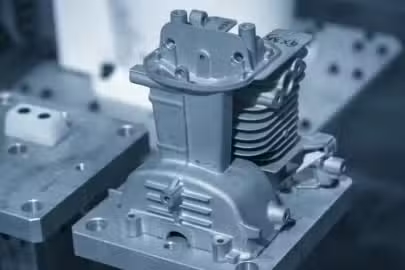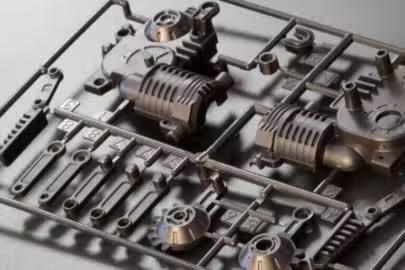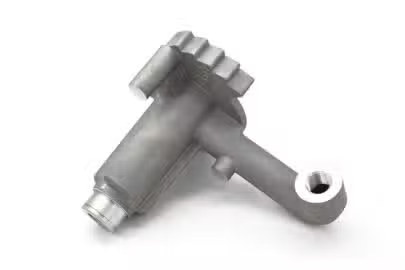Introduction
Die casting involves heating metals and alloys into the molten form before forcing them into a mold cavity under high pressure, where they cool down and solidify into the desired shape. The manufacturing process is highly versatile for manufacturing metal parts and components, particularly non-ferrous metals like aluminum and zinc.

The operation is more complex than described, with various factors affecting the success. Still, it’s a common manufacturing technique for various industries because of its efficiency and cost-effectiveness. However, if the proper precautions are not adhered to, you may experience die casting defects.
This article explores die-casting drawbacks and defects, explaining the causes and solutions. We also went further to provide you with expert tips to avoid die-casting defects. Read ahead!
Classification of Die Casting Defects
In this section, we’ll classify die-casting defects into four categories, depending on the causes and where they predominantly affect casted parts.
Surface Die Casting Defects
These refer to die casting flaws and imperfections that are easily visible on the surface of the parts. We will further discuss each form of surface die casting defect.
Flow Marks
As the name suggests, flow marks are irregular patterns or stripes occurring on the surface of die casting that look like marks of flowing liquid (molten metal). The lines, usually with no specific direction, have distinct dolors different from those of the casting, enhancing its visibility. However, finishes such as painting can remove these imperfections.
Causes
- Low die temperature
- Use of excess lubricant
- Small cross-sectional area
- Low filling pressure or high filling speed
Solution
- Modify the cross-sectional area or reposition the in-gate
- Optimize filling speed and pressure
- Pre-heating the molds, too, may prove effective.
Cold Insulation
Cold insulation occurs when areas with a dull finish result from incomplete material flow. It is sometimes called cold shut, though they are pretty different. Cold shut refers to irregular linear narrow lines or patterns on the cast surface, resulting from inadequate fusing of molten metal in the die cavity.
Causes
- Inadequate heating temperature of molten metal or die
- Poor design of the gating system
- Inadequate fluidity of the molten metal
Solution
- Modify the metal-injecting parameters
- Increase the heating temperature of the mold and the molten metal
- Modify the gate design, or change the size and position and increase the plunger speed
- Consider preheating of the die cavity
Bubbles or Bubbling
As the name suggests, bubbles occur as irregular air pockets or voids underneath the surface of die castings. It is typically a result of gas expansion during the die casting process.
Causes
- Overly high melting and mold temperature
- Excessively high die casting speed
- Rapid cooling
Solutions
- Modify metal injection speed
- Control the mold cooling
- Enhance venting to prevent gas entrapping
Cracks
Cracks occur due to material breakage, which may arise from excessive stress within the material. It presents as irregular fractures or patterns on the surface of die castings. Cracking tends to occur during cooling or solidification. Besides stress from within, cracks may also result from pressure build-up from external influence, such as during cutting or in the mold, such as during ejection.
Causes
- Uneven or rapid cooling
- Low mold temperature
- High amounts of impurities in the metal alloy
Solution
- Practice controlled cooling
- Optimize mold design to minimize possible points of stress concentration
Others
Besides the main surface die casting defects, below is an overview of others that may affect your casting parts.
- Carbon Deposit: This refers to the appearance of dark spots or patches on the surface of die casting parts. These surface defects may arise from contamination of the die cavity or the molten metal with carbon particles. Therefore, to avoid this, ensure proper maintenance and cleaning of the cavity. Also, ensure optimal lubrication using low-carbon lubricants to ensure smooth ejection of die castings.
- Burrs: These are noticed as uneven projections or excess materials emanating from the edges of die casting. The causes of these defects include die misalignment or wear and tear of the die cavity. Poor gating and ejection systems may also be a cause.
- Sand Holes: This refers to the presence of voids, pores, and cavities on the surface of die casting. Optimize the venting systems and use high-quality metal alloys for your die casting to avoid this.
- Strains: This occurs as distortions or warping on the surface of die castings, often due to excessive heating or uneven cooling.
- Oxidation and Discoloration: This refers to distinct changes in the color of specific areas in die casting parts. The leading cause is exposure to oxygen during casting or overly high die temperatures. Therefore, optimizing and controlling die casting temperature and the atmosphere during die casting is critical for avoiding these defects.

Internal Die Casting Defects
These are die casting defects that are entrapped into the manufactured parts. Therefore, unlike surface defects, they are not easily noticeable but still affect the integrity of the casted part.
Insufficient Filling
As the name suggests, this suggests that there’s incomplete filling of the die casting mold cavity with the molten metal. It often results in unfinished parts, altering the die-casted part’s structural integrity.
Causes
- Inadequate injection pressure
- Poor gating design
- Insufficient fluidity of molten metal
Solution
- Optimize die casting gating systems
- Enhance injection pressure
- Conduct simulations before actual die casting to ensure proper fluidity and flow of molten metal through the die cavity.
Porosity
As the name suggests, this refers to gas pores in the cast part after cooling and solidification. They appear as round, oval, or irregular air pockets or voids underneath the die casting parts’ surface, sometimes discolored. It may result from air entrapments or gas expansion during the die casting.
Periodically, these gasses are released during melting, and it’s no issue when the metal is in liquid form. However, during cooling and solidification, it remains trapped, often due to problems with the venting system.
Causes
- Higher melting temperature, which results in the release of hydrogen gasses from molten metal alloys
- Turbulence arises from the molten metal’s rapid filling in the die cavity, which remains even after solidification.
- Increased pre-heating mold temperature
Solution
- Melt the metal alloys in a vacuum under flux to prevent gas from penetrating.
- Optimize die-casting parameters – especially the filling speed.
- You could also melt around a low soluble gas; this prevents gasses from mixing with the liquefied alloy.
Shrinkage
Shrinkage is also formed during the cooling and solidification process of die casting. This defect will likely occur when the manufacturer fails to adhere to the necessary die casting precautions. As the molten metal alloy cools down and solidifies, it also shrinks. Therefore, shrinking is almost bound to happen, but it becomes a problem when it creates holes and pores in the cast, resulting in distortion in shapes.
Besides creating pores, shrinking may also result in warping or increase the stress in the metal, increasing the chances of cracks and fractures in the final die cast.
Causes
- Early opening of the die-cast mold
- Inappropriate die-casting cooling system design
- Overly high die-casting temperature, especially during the pouring
- Uniform wall thickness
Solution
- Improve die-casting structure to eliminate metal accumulation and permit uniform wall thickness.
- Optimize the gate system.
- Adhere to specified alloy melting temperature and reduce pouring temperature.
- Optimize the molten metal pouring system.
Inclusions
Inclusions refer to the presence of foreign particles within the die casting parts. These particles often arise from contamination of the die casting process, allowing sand, rust, and deoxidation products in the metal castings or dross. Die castings with infusions tend to experience issues with their mechanical properties and may not offer the intended functionality of the part.
Causes
- Contamination and impurities arising from inadequate metal purification
- Improper melting of metal alloy
- Inadequate furnace charge purity
- Metal interaction with the atmosphere or mold surface.
Solution
- Clean the mold and die cavity to prevent contamination
- Ensure that the furnace charge is pure
- Ensure proper purification of the molten metal to remove slags, dross, and other impurities.
Dimensional Die Casting Defects
These are defects that alter the dimensions of the cast parts. It could relate to the part’s shape, size, or failure to attain intended precision and accuracy.
Deformation
This refers to when the shape or form of the die casting parts matches the intended design of the die casting components. It’s often a result of issues with the die casting parameters on the part of the manufacturer.
Causes
- Poor die casting design
- Wrong removal of the gate
- Poor timing of the mold opening
- Poor die casting ejection system
Solution
- Ensure proper die casting design
- Ensure uniform ejection and optimize gate removal
Dimensional Deviation
This simply refers to die casting parts’ size, dimensions, or geometry variations. Even if it’s a minimal deviation, once the parts’ precision is questionable, we say there’s a dimensional deviation. Dimensional deviation issues may arise from other defects such as warping, uneven wall thickness, or shrinking.
Causes
- Uneven cooling and solidification
- Inaccurate die design
- Inconsistencies in the properties of material used in die casting
Solutions
- Manufacturers should ensure strict quality control at every stage of the die casting process.
- Optimize die design to ensure optimum cooling.
- Ensure the selected metal alloy for die casting has consistent mechanical and chemical properties.
Material Die Casting Defects
Die casting defects may also arise from the selected material for your fabrication. Below are ways the issues directly link to the material.
Hard Points
Hard points refer to increased hardness on localized areas within a die casting part. Therefore, there’s an uneven hardness in the manufactured product, which may affect the part’s structural integrity. This defect may arise from issues with uneven cooling, improper composition of the alloy, or poor control of temperature during cooling or solidification.
Therefore, manufacturers must control the die casting temperature to ensure uniform heating and cooling to eliminate these challenging points. Also, provide appropriate quality control measures, such as validating the alloys before die casting and verifying every manufacturing stage during die casting.
Incompatibility With Post-processing
After die casting, it is not unusual for manufacturers and OEMs to proceed with post-processing operations to improve the overall properties of the metals. However, if the surface finishing is incompatible with the material choice, it could result in defects.
Typical material defects relating to incompatibility with post-processing operations include poor surface adhesion and unwanted chemical reactions. The straightforward way to avoid this is to carefully select the suitable surface finishing for your die casting parts.

Manufacturing Tips to Prevent Die Casting Drawbacks
Thus far, we have established that die casting drawbacks and defects may arise from different factors. We also provided you with solutions to these issues.
However, below are expert advice and tips to prevent these issues.
Use Appropriate Wall Thickness
The wall thickness of the design, whether inadequate or excessive, may produce defective die castings. Optimizing the wall thickness may prove effective for preventing defects such as warping, porosity, and shrinkage.
Conduct correct analysis to determine the optimum wall thickness for your die casting designs. In doing this, you should factor in the material choice – its properties – and the part’s shape and geometry you are working with. Generally, the minimum wall thickness for magnesium and aluminum die casting parts is about 1.5 to 2.5 millimeters, and even less for zinc, about 1 millimeter.
Optimize Gate Design
Reading through the causes of some die casting defects, you’d notice that issues with the metal flow pattern cause some. The gate design is the main factor relating to the flow of molten metal. Therefore, optimizing the gate will prove effective in eliminating such defects.
Below is a simple stepwise calculation to optimize the gate, modifying the flow pattern.
- Using PQ2, calculate the appropriate gate size, runner designs, and plunger size. Doing this helps optimize the die cavity’s gate velocity, fill time, and pressure build-up.
- Divide the cast into different zones.
- Also, divide the gates to allow the filling of each zone simultaneously.
- Avoid mixing to ensure the prevention of die casting drawbacks.
Modify Fill Time
The fill time in die casting starts before filling the die cavity. It begins when the molten metal approaches the gate. Ensure to control the fill time, as it helps to prevent defects such as air trapping and inadequate filling. Modify the fill time based on the part’s complexity, material properties, and the die cavity design.
Again, using the PQ2 calculations, you can predict the appropriate fill time. It also gives you insight into how changes in variables such as the gate area, hydraulic pressure, plunger size, and speed setting influence the gate velocities and fill time. The goal is to ensure smooth, controlled filling for high-quality die castings.
Use the Right Die and Melting Temperature
Inadequate heating of the die temperature or the liquefied metal is another common cause of die casting defects. Casting at low temperatures will cause the molten metal to cool down faster than average, affecting the casting process. This may even cause solid metals to form before they should, stiffening the stream and reducing mixing.
Ultimately, it could result in defects such as cold insulation, cracks, or cold shots. Therefore, you must monitor and control the die temperature, as well as that of the molten metal, to ensure maintaining casting at the optimum temperature.
Work With an Effective Die Casting Rating System
Implementing an effective die casting rating system will help evaluate the casting process. It’ll help you analyze if you are reducing the chances of defects or worsening the situation. It could also suggest areas to correct or optimize, lowering risks of die casting shortcomings. This rating system is most effective against internal die casting effects, such as porosity, inclusions, and shrinkage.
Is Die Casting the Right Choice for Your Fabrication?
Whether die casting is the right manufacturing choice depends on your fabrication needs. Die casting is the right choice for your project if it requires highly precise, detailed, and consistent parts.
If your design calls for metal alloys, particularly non-ferrous metals like aluminum, then die casting is ideal for your fabrication. The process suits manufacturing parts for automotive and electronic industries, including aerospace and medical sectors, where high precision is a priority.
Just adhere to all the necessary manufacturing tips to avoid potential defects; then, you can be assured that the process will create parts that suit your requirements.
Partner With Zintilon to Prevent Die Casting Drawbacks in Your Fabrication
It is not enough to understand the complexities of the die casting process; adhering to the parameters is crucial for high-quality fabrication. An experienced and reputable die casting manufacturer for your manufacturing project will help you avoid many defects.
Zintilon offers high-quality die casting services, devoid of the manufacturing processes drawbacks and defects. Our facilities consist of highly skilled professionals who are knowledgeable in the science and art of die casting, among other related technologies.
Conclusion
While die casting is versatile and efficient, you must adhere to the fundamentals of this manufacturing process to avoid experiencing some of its defects. Ensuring that all die casting parameters are appropriately analyzed and integrating proper quality control in each process step is vital to preventing these defects.
FAQS
How Can You Reduce Die Casting Drawbacks?
Optimizing die casting parameters is the key to reducing its drawbacks. Many of these defects arise from inadequate temperature, fill time, metal flow pattern, rapid cooling, and flawed gate design, among other parameters. Assessing and refining these features will help increase die-casting efficiency and reduce the risk of die casting defects.
What Are the Shortcomings of Die Casting?
Die casting shortcomings include porosity, shrinkage, cracks, flow marks, cold insulations, etc. These defects are grouped based on areas of the die castings where they affect, such as surface and internal defects.
How to Rid Die Casts of Porosity?
Removing porosity, often due to entrapping gas bubbles, involves improving the venting systems and optimizing the fill times. Manufacturers and OEMs should ensure proper assessment of the die cavity, as an appropriate mold design is less likely to cause porosity. Also, they should factor in the material properties and ensure that the die casting process occurs at optimum temperature.
Great, Together


